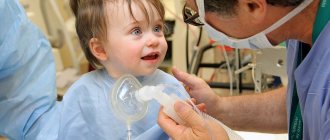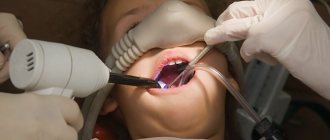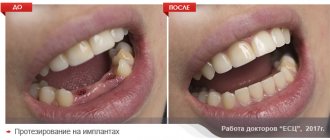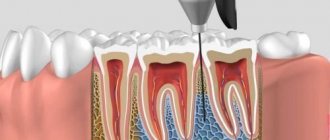Types of anesthesia in pediatric dentistry
Modern dental technologies are very diverse.
Hypnosis, musical sound analgesia, laughing gas, electroanesthesia, and infiltration anesthesia can be used as anesthesia for children during dental treatment. But more often they use methods based on proven medications and compounds. Protocols can be classified according to a variety of criteria. General gradation:
- local anesthesia;
- Oxygen sedation;
- deep sedation;
- general anesthesia.
There are also different methods of how dental anesthesia is given to children:
- topical anesthesia - smearing the gums with an anesthetic to locally “freeze” the nerve endings;
- injection anesthesia - administration of the drug using a carpule syringe with a particularly thin needle;
- mask for children - used in dentistry to administer anesthesia or a nitrogen mixture.
The names of drugs for pediatric anesthesia during dental treatment deserve special mention. Most often this is:
- Sevoran for general anesthesia is a highly effective inhalation anesthetic with the highest safety profile.
- Propofol for deep sedation is a completely safe composition for intravenous anesthesia.
The method of pain relief is selected taking into account the patient’s age, indications for use, and the amount of planned dental work.
What are the benefits for children?
Application anesthesia in dentistry for children begins to act in almost five to ten minutes. Anesthetics are produced as various gels, ointments, and sprays. Before performing dental surgery, a special antiseptic is most often used , after which is applied to:
- hard dental tissues;
- pulp;
- mucous membranes.
The application has a mild effect without damaging deep tissues. In this case, the depth of impact is within three millimeters. The analgesic effect lasts for half an hour, which allows the doctor to carry out treatment . If more time is needed, the drug is reapplied.
Application anesthesia does not cause fear in children, since it makes dental procedures virtually painless. The main substances of the drugs are tetracaine, lidocaine, benzocaine. The substances presented are intended to dull pain and block the sensitivity of nerve endings. The advantages of the procedure include complete safety and affordable cost.
Local anesthesia in dentistry for children
Local anesthesia is an anesthesia that temporarily blocks the transmission of nerve impulses. This means that during the treatment the child does not feel pain or discomfort. Dentists use local anesthetics as medications, selecting the composition after determining the patient’s allergic reactions.
Local anesthesia for children's teeth is usually carried out in two stages:
- application - for primary reduction of sensitivity;
- injection - administration of an anesthetic composition through an injection of an anesthetic.
Anesthesia for the treatment of baby teeth in very young patients takes place in three stages. The first is application “freezing”. The second and third are injection anesthesia. The first injection of anesthetic is performed with a minimum dose, a drop. Anesthesia takes effect almost immediately, after which the entire volume of the drug is administered.
Rodikova Tatyana
With children 3-4 years old we usually play a fairy tale - based on Frozen or invent our own. First, we smear the gums with “magic ice jam”, then we cast a spell like Elsa “to freeze microbes.” And after that we “make Olaf the snowman” or simply “freeze everything around.” Kids are happy to listen and help, which eliminates tears and whims during dental treatment.
Types of Local Anesthesia
The type and dose of anesthesia will depend on many factors. These include patients' age, weight, allergies, body part being operated on, and any current health conditions.
Various drugs are used to block pain. They can be applied by injection or by applying a spray or ointment.
The drug works by targeting specific nerve pathways to prevent the nerves in the area of application from sending signals to the brain.
Typically, the drug takes effect within a few minutes and wears off within a few hours. A stronger and higher dose will last longer.
Cocaine was the first anesthetic, but is now rarely used. Lidocaine is currently the most widely used local anesthetic, but different drugs are used for different purposes.
For longer procedures, bupivacaine is more suitable, but it may be more painful when first used. Therefore, the anesthesiologist may use lidocaine first and then administer bupivacaine if numbness is required for a longer period.
Synthetic anesthetics are similar in structure to cocaine, but these drugs do not have the same potential for abuse.
Oxygen-nitrogen sedation
ZAX is a mixture of oxygen and nitrous oxide, often known as laughing gas. Served through a mask. After inhaling the gas, the child falls into a relaxed, sleepy state, calmly perceives the surrounding reality, hears and understands speech addressed to him.
- maintains a positive mood - at the same time as treatment, the child watches cartoons and gets great pleasure from it;
- neutralizes pain - the pain threshold increases, which allows you to endure dental treatment comfortably and calmly;
- reduces natural reactions - the child is no longer frightened by bright lamps and the buzzing of the drill.
Superficial ZAX sedation is recommended for patients over three years of age and, with an experienced doctor, can replace pediatric anesthesia during dental treatment.
Preparing for local anesthesia
If the patient is undergoing surgery with local anesthesia, the doctor should explain in advance how to prepare.
Patients should tell their doctor if they are using any medications, especially if they are blood thinning agents such as aspirin or warfarin.
Your doctor may instruct you not to eat anything for several hours before surgery. It is also important not to drink alcohol for 24 hours before taking the anesthetic.
In the doctor's office, the doctor applies a local anesthetic to the appropriate area of the body. It will start to feel numb.
The doctor will not act if the patient does not feel numb.
The anesthetic will prevent any pain, but the patient may still feel pressure during surgery.
Depending on what the procedure is and how anxious the patient feels, a sedative may be prescribed at the same time. This will help the patient feel calm and less anxious.
The doctor will monitor the amount of oxygen in your blood using a small device placed on your finger. In rare cases, a plastic nasal tube will be used to provide supplemental oxygen.
Deep sedation with Propofol - drug-induced sleep
During dental treatment, anesthesia for children or deep sedation may be used. These concepts are often confused, since in both cases the child is immersed in medicated sleep. But the difference is significant:
- General anesthesia in dentistry is given to children through a mask. Artificial sleep is as deep as possible, with complete loss of sensitivity.
- Sedation with Propofol involves intravenous administration of the drug and requires additional pain relief.
Propofol guarantees:
- natural physiological state of sleep;
- falling asleep in 1-2 minutes;
- exceptionally high safety for the child;
- simple awakening and rested state;
- extremely low risk of allergic reactions and side effects.
The quality and depth of sleep is controlled by an anesthesiologist. At this time, dentists treat and save teeth, remove completely destroyed units, and install prosthetic structures.
Deep sedation with Propofol - drug-induced sleep
Dental anesthesia for children
Dental treatment for young children under anesthesia raises the maximum number of questions among adults. The main ones relate to the safety of the procedure and side effects. Parents are also interested in what kind of anesthesia they give their children during dental treatment - whether there are high risks of negative consequences.
Is anesthesia harmful for dental treatment for children?
Sevoran is a non-narcotic, non-toxic, completely safe drug that is used in dentistry for treatment under general anesthesia. It is given to the child through a mask, instantly putting him to sleep.
Among the advantages of the drug, confirming its safety for young patients:
- excreted from the body unchanged;
- does not affect internal organs;
- does not depress the heart;
- maintains physiological blood pressure readings.
Sevoran simply turns off consciousness and does not cause side effects. Additional positive points:
- pain relief - doctors do not administer additional drugs to the child;
- pleasant smell - children themselves breathe through the mask with pleasure;
- quick recovery from anesthesia - awakening takes only 10-15 minutes.
The high quality of the composition ensures that the use of anesthesia for dental treatment for children eliminates any unpleasant consequences.
Anesthesia at the dentist for children: features
Having figured out whether it is possible to treat a child’s teeth under general anesthesia, parents begin to prepare the child for the procedure.
To do this, the young patient is prescribed a series of examinations:
- Consultation with a dentist.
The doctor must assess the amount of work - determine caries, pulpitis, and the intensity of tooth destruction. Together with the parents, a decision will be made on how many teeth to treat, what to remove, and whether prosthetics are necessary. - Testing, primary diagnostics.
The basic set of studies is general and biochemical blood tests, electrocardiogram (ECG).
- Obtaining permission from a pediatrician.
If there are chronic diagnoses, the child is also sent for a consultation with a specialized specialist in order to eliminate any risks during dental treatment.
When all issues are agreed upon, the doctor sets a date for treatment and gives final recommendations.
Soldatenkova Alina
When removing baby teeth, it is very important to preserve space for future permanent ones. To do this, they either undergo prosthetics or go to an appointment with an orthodontist to install an orthodontic seat holder.
Parents about anesthesia
An operation is always a very important moment in a child’s life. You have to leave the familiar and safe environment of home, be in an unusual place, communicate with strangers. But this difficult period can also become a positive experience in a child’s life if you teach him to adapt to an unfamiliar environment. How this period goes largely depends on the help and support of parents, which the child needs more than ever at this time. The purpose of this message is to give recommendations on how to properly prepare a child for surgery and help him survive this period as painlessly as possible. In the days before hospitalization, we advise parents to review the booklet with their child, tell him about his illness or problem, the purpose of the surgical intervention and about anesthesia. Let the child tell you what he thinks about it, parents should try to answer all his questions. Deception should be avoided in this conversation, even if it seems reassuring.
What is anesthesia? Components and types of anesthesia
Anesthesia is a state in which the patient is unconscious, his body is motionless, relaxed and does not feel pain. Anesthesia literally means a decrease in the sensitivity of the body or part of it, up to the complete cessation of perception of information about the environment and one’s own condition. The main purpose of anesthesia is to ensure adequate protection of the human body (in this case, a child) from pain, metabolic, and emotional stress. In adult patients, anesthesia is administered in most cases during surgical operations. At the same time, in children, almost all painful manipulations, for example, painful dressings, examinations of the bladder (cystoscopy) or respiratory tract (bronchoscopy), various x-ray examinations (often magnetic resonance or computed tomography, requiring the child to remain motionless for a long time) also performed under anesthesia.
Anesthesia components
Modern anesthesia must provide several components:
- switching off consciousness - the child should not be “present” at his own operation, he should be in a state of medicated sleep;
- analgesia - elimination of pain sensitivity;
- amnesia - lack of memory (the child should not remember the period of the operation/manipulation and wake up without negative memories);
- sometimes an additional, fourth component of modern anesthesia is required - myoplegia. This happens when it is necessary to relax all the muscles during surgery. This applies to “major” operations: on the lungs, abdominal organs, spine, large joints, cranial cavity;
- Finally, today anesthesia is not carried out without monitoring - this term currently refers to careful monitoring of body functions and processes in order to prevent complications of surgery and anesthesia.
It is monitor control that allows for safe and high-quality anesthesia.
Types of anesthesia
Modern anesthetic care can be provided using a large arsenal of methods and tools used. The following main types of general anesthesia can be distinguished:
- single-component anesthesia - is carried out using one drug administered in various ways: through the respiratory tract (inhalation), intravenously, intramuscularly. This anesthesia is used for “minor” operations, painful manipulations and research;
- combined anesthesia - a combination of various drugs is used - inhalation and/or intravenous. This makes it possible to use the beneficial qualities of each component of general anesthesia;
- Regional anesthesia involves blocking pain transmission from peripheral nerves to the central nervous system by injecting a local anesthetic solution. Thus, the surgical area becomes insensitive to pain. It should be noted that regional anesthesia methods are practically not used independently in children, but their combination with general anesthesia is increasingly used in the practice of pediatric surgery. In this case, general anesthetics are used to turn off consciousness, and the remaining components are provided using regional anesthesia;
- Combined anesthesia is a method of anesthesia when general anesthesia is combined with regional methods of anesthesia.
Based on the method of drug administration, anesthesia can be divided into:
- inhalation - the anesthetic enters the patient’s body through the respiratory tract, which can be: mask - the anesthetic is supplied through a mask located on the face. With this type of anesthesia, injections are given to the child when he is already unconscious and does not feel anything. Modern inhaled drugs can cause blackout within a few breaths. Most “minor” operations and manipulations are performed in children under this type of anesthesia. endotracheal - in this case, after turning off consciousness, an endotracheal tube is inserted into the child’s trachea, through which artificial respiration is carried out and inhalation anesthetics are administered. This type of anesthesia is used for “major” operations (on the thoracic and abdominal organs and others) and special manipulations.
- intravenous - drugs are administered intravenously through a catheter placed in a vein.
Who administers the anesthesia?
An anesthesiologist is a specialist who administers anesthesia. In order to obtain a certificate as an anesthesiologist in Russia, a doctor must not only obtain a diploma of higher medical education, but also complete a two-year residency in the chosen specialty. The tasks of an anesthesiologist include not only the selection of drugs for anesthesia, but also, mainly, ensuring life safety and comfortable conditions for the patient. During the operation, the anesthesiologist constantly monitors and manages all the vital functions of the body under conditions of operational stress: breathing, blood circulation, metabolism. The anesthesiologist is constantly next to the patient and continuously monitors his condition / immediately responding to the slightest changes. Thus, the successful outcome of surgical treatment as a whole and the safety of the patient largely depend on the experience, knowledge and practical skills of the anesthesiologist.
Meeting with an anesthesiologist
Typically, the child and parents meet with the anesthesiologist for the first time before surgery/manipulation. The doctor examines the child and collects from the parents the necessary information about the history of the child’s development and diseases (history). It is very important to tell the doctor all the information he is interested in. This will help the anesthesiologist determine the plan for the necessary anesthetic examination and the method of anesthesia that should minimize the risk during the proposed operation/manipulation. The anesthesiologist must assess the patient’s level of preparedness, finally decide on the anesthesia technique, explain the features of the chosen anesthesia and the rules for preparing for it, and also discuss all issues of interest with the child’s parents. What is important to ask your anesthesiologist?
- Drugs administered before surgery (premedication) and during it;
- What will be required of the child during induction of anesthesia;
- Until what moment can you stay with your child?
- What is the expected duration of anesthesia;
- When will the child come to his senses, how will the recovery proceed and when will you be able to see him;
- How to behave correctly after anesthesia (surgery) to help your child recover as comfortably as possible;
- If your child is taking medications, it is important to ask the anesthesiologist whether they need to be taken on the day of surgery, and if so, when and in what quantities.
The conversation between the parents and the anesthesiologist ends with the signing of a document called “Informed Consent for Anesthesia.” The Informed Consent records the results of the conversation, including information about which treatments the parents consider unacceptable for their child. If the operation is performed for emergency reasons and the parents are not in the hospital, the child can be operated on without obtaining informed consent with such a decision formalized by a council of specialists. Before parents sign informed consent, the anesthesiologist must provide enough information for them to make an informed decision. Communication between parents and the doctor presupposes a high degree of trust in the professional competence of the anesthesiologist. Parents have the right to express, and the anesthesiologist, if possible, fulfill wishes about the method of anesthesia. However, it is also important to understand that no matter how unique their child’s case may seem to the parents, something similar has probably already happened in the anesthesiologist’s practice. Under no circumstances does the anesthesiologist seek to violate the parental ban on carrying out certain activities. But, if parents impose such a restriction, they must be aware that every doctor is responsible for the patient’s health - this is his professional task. Any proposed treatment is intended solely for benefit, and a categorical prohibition may hamper the effectiveness of the medical process.
Preparing a child for anesthesia
Particular attention should be paid to preparing children for anesthesia. For planned surgery, the child may have a light dinner the night before and should follow the usual drinking regime. You should also wash your baby thoroughly. It is very important that the child's stomach is empty before surgery. This measure improves the safety of anesthesia. During anesthesia, the reflexes of the human body are weak, therefore, if food or liquid remains are present in the stomach, then in the event of nausea and vomiting, there is a risk of them getting into the lungs, and this is very dangerous. Please ask your anesthesiologist what restrictions your child should follow. Particular attention should be paid to the child’s psychological preparation for surgery. When communicating with a child, it is very important to follow a few simple rules:
- Be calm! Children's anxiety coincides with the anxiety of parents. The ideal psychological preparation of a child for surgery is that the parents themselves are calm and wise about the upcoming process. Recent research has shown that reducing anxiety in parents, in turn, helps reduce anxiety in children.
- Be honest with your child. Parents must explain to the child why the operation is necessary and honestly tell the child about it, taking into account their age and development. The story is better perceived by the child in a simple, conversational form without medical details of the upcoming process.
- The child must clearly understand that everything is done only for his benefit.
- When talking to a child, you can use the following words: “The doctor needs to fix something so that your body is healthy and beautiful.”
- It is very important that the child understands that he will sleep during the operation. In a dream, people don’t feel, don’t hear, don’t see anything. The doctor will give him a medicine that will make him fall asleep, and he will only wake up when the operation is over.
- You should choose your words carefully.
Some medical terms may frighten a child. For example, when talking about anesthesia, you would be better off using the following expressions: “put you into a special medical sleep” or “take a breath of sweet air.” Choose more positive words, such as “prick” (instead of “needle”), “crib” (instead of “gurney”), “fix” or “repair” (instead of “cut off” or “remove”). Be careful when using words like "put to sleep." This may have double meaning for children whose pets do not return home after being “euthanized.” Parents must make promises that they can definitely keep. Say: “Bye! I’ll wait for you, and we’ll see you when you wake up!”, instead of: “I won’t leave you anywhere” - since this is impossible. You should not bribe or, on the contrary, intimidate a child. Such actions can only help for a short time, but will have a bad effect on the child’s psychological state in the long term.
Use optimal ways to deal with stress at different age stages of the child:
| 1-3 years | Early childhood | 1. The presence of loving, calm parents 2. Art therapy (drawing, sculpting upcoming events) 2. Fairy tale therapy (we come up with a fairy tale with a good ending about an operation on a bunny, bear cub or boy/girl) |
| 3-6 years | Game age | 1. The presence of loving, calm parents 2. Art therapy (drawing, sculpting upcoming medical events, where it is important to allow the child to be the “author” of saving the patient) 3. Fairy tale therapy (we come up with a fairy tale with a good ending about an operation on a bunny, bear cub or boy /girls) 4. Role-playing games (play in the hospital with dolls, soft toys, with a toy doctor set) |
| 6-12 years | School age | 1. The presence of loving, calm parents 2. Simulating a situation with a successful operation 2. Using books or a computer to collect information about the operation |
| 12-18 years old | Youth | 1. The presence of loving, calm parents 2. Information: the teenager needs to understand what to expect and what the sequence of the operating procedure is. Preoperative information should be age-appropriate. For example, teenagers are more interested in information from the Internet about their illness rather than the results of scientific research. |
On the day of surgery you must:
Remember that the child should not eat before surgery. Even chewing gum and candy are prohibited! Wash the child thoroughly. On the day of surgery, it is necessary to remove everything unnecessary from the child:
- jewelry, earrings, nail polish;
- if the child wears contact lenses, they must also be removed;
- If the child wears dental plates, consult the anesthesiologist about whether and when they should be removed.
If your child has a loose baby tooth, tell the anesthesiologist. The medical staff will check that there is no risk of the tooth falling out during the operation. If the child is taking medications, then on the day of surgery he should take them in accordance with the recommendations of the anesthesiologist. Talk to your child again about how the job of doctors and nurses is to help him and take care of his health. Make sure that he understands why the operation is needed and perceives the upcoming medical intervention as helping his body.
Postoperative recovery
The process of awakening after general anesthesia consists of a gradual return to independent breathing, restoration of sensitivity and movement. The anesthesiologist will try to make this process as comfortable as possible for the child. It is possible that after the operation the child will experience pain for some time, but the clinic staff has everything necessary to cope with this pain. Upon returning home, the child is likely to show himself to be more dependent: he may wake up at night, try to be with you more often than usual, and be afraid of strangers. All this will normalize over time. The most important thing at this time is the peace and love of parents. If the child wants to return to the topic of the medical intervention he experienced, praise him and tell him that you are proud of how courageously he showed himself and how well done he was for overcoming this situation. Then shift your child's attention to positive thoughts and actions.
Frequently asked questions from patients:
1.When can elective surgery be cancelled? Answer: The most common reason for such withdrawal is an acute illness of the child: ARVI, childhood infection (measles, scarlet fever, etc.), colds, fever, diarrhea, repeated unexplained vomiting. Anesthesia in these cases can cause various complications.
2.Is there a risk of complications during anesthesia? Answer: Unpredictable reactions of a particular organism are possible, which is why such careful preparation for anesthesia takes place. In modern medicine, an anesthesiologist has sufficient knowledge, skills and tools to cope with even the most difficult situation.
3.Is there a risk of waking up during anesthesia? Answer: Rare cases of intraoperative awakening have been described in the world literature, but currently anesthesiologists use modern objective methods of monitoring the level of consciousness, which makes it possible to successfully prevent such episodes even in cases where the patient cannot report it. Thus, the risk of waking up during surgery is almost reduced to zero.
4. Will there be pain during the operation? Answer: The primary task of the anesthesiologist is to protect the patient from pain. In some cases, due to the characteristics of the body, anesthesia may not completely eliminate pain sensitivity, however, the anesthesiologist always has a number of alternative techniques in his arsenal that will help him cope with any situation and prevent the presence of pain. The anesthesiologist remains close to the patient throughout the operation and has all the necessary knowledge and equipment to provide safe and comfortable anesthesia.
5.Can anesthesia affect the child’s further development, his memory, attention, and learning abilities? Answer: General anesthesia is a process that, in its complexity and depth of impact on the body, is quite comparable to surgery. Accordingly, “small” surgical interventions do not have any visible impact on the further development of the child, while “major” surgical interventions force one to change their lifestyle for some time, reduce mental and physical stress, and carry out special procedures that accelerate the recovery of the child’s body. Something similar can be seen in relation to general anesthesia. Currently, modern anesthesia drugs preserve the child’s cognitive abilities as much as possible. After prolonged anesthesia, postoperative rehabilitation therapy is sometimes required to promote final recovery. Thus, the use of modern drugs for general anesthesia ensures a favorable outcome of medical intervention.











